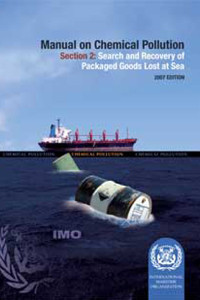
This publication provides guidance on ways of assessing hazards associated with spillages of hazardous and noxious substances and of setting up response organizations. It also describes safe operational practice in response.
In recent years, there has been a rapid growth in the transport and storage of hazardous and noxious substances (HNS). If allowed to escape, these materials can present a danger to a ship’s crew, the vessel, coastal populations and/or the environment. Accordingly, public concern over these materials has grown, and both Governments and industry have taken steps to address and respond to such incidents.
Marine spills involving HNS are not as frequent as oil spills and may receive little publicity due to their less visible nature. However, on a global basis, marine spills involving HNS are not rare. In fact, a worldwide survey of marine HNS emergencies showed that:
- There is a wide range of cargoes which need to be considered as potential threats
- most accidents involved mainly two classes of HNS: flammable liquids and corrosive materials
- one to two major HNS accidents can be expected each year
- a wide variety of ship types were associated with HNS accidents
- HNS accidents were almost equally divided between ‘‘bulk’’ and ‘‘packaged goods’’ shipments.
Foreword
This publication, prepared by the Marine Environment Protection Committee of the International Maritime Organization (IMO), supersedes the 1986 edition of section 1 of the Manual on Chemical Pollution. For the purpose of this Manual, hazardous materials (HNS) include, but are not limited to: noxious liquid substances, described under Annex II of MARPOL 73/78 and the International Bulk Chemical Code (IBC Code); dangerous goods, described in the International Maritime Dangerous Goods Code (IMDG Code); gases regulated under the International Gas Carrier Code (IGC Code); and solid cargoes covered by the Code of Safe Practice of Solid Bulk Cargoes (BC Code). It provides guidance to Governments on ways of assessing hazards associated with spillages of hazardous and noxious substances and of setting up response organizations. Further, it describes safe operational practice in response. The present section of this Manual does not deal with the recovery of packages lost during incidents at sea, nor with problems particular to radioactive and explosive substances. These matters are covered in section 2 of the Manual: Search and Recovery of Packaged Goods Lost at Sea.
Problems related to oil pollution casualties and related information are specifically addressed in the Manual on Oil Pollution (sections I to VI).
Chapter 1: Introduction
Chapter 2: Regulatory framework for the carriage of HNS at sea
Chapter 3: Hazards and fate of released HNS
Chapter 4: Chemical emergency preparedness
Chapter 5: Response methods and techniques
Chapter 6: Case histories
A??s a specialized agency of the United Nations, IMO is the global standard-setting authority for the safety, security and environmental performance of international shipping. Its main role is to create a regulatory framework for the shipping industry that is fair and effective, universally adopted and universally implemented.
In other words, its role is to create a level playing-field so that ship operators cannot address their financial issues by simply cutting corners and compromising on safety, security and environmental performance. This approach also encourages innovation and efficiency.
Shipping is a truly international industry, and it can only operate effectively if the regulations and standards are themselves agreed, adopted and implemented on an international basis. And IMO is the forum at which this process takes place.
- Number of Pages:
- 118
- Published Date:
- January 2009
- Book Height:
- 250 mm
- Book Width:
- 210 mm
- Author:
IMO
- Preview:
- Yes
- ISBN:
- 9789280160963
- Binding Format:
- Paperback
- Publication Date:
- July 2010





